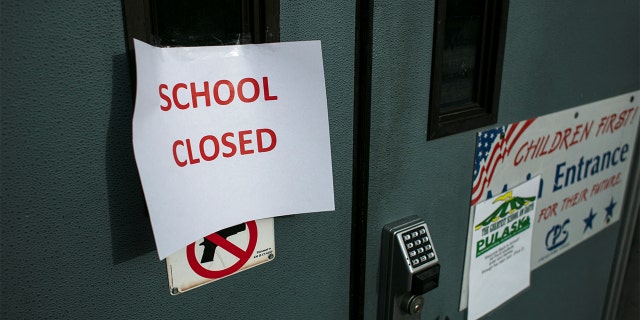NEWYou can now listen to Fox News articles!
A study shows remote learning led to large losses in achievement for students during the pandemic, with blue states and students from low-income areas hit the hardest by the losses.
“Interestingly, gaps in math achievement by race and school poverty did not widen in school districts in states such as Texas and Florida and elsewhere that remained largely in-person,” Thomas Kane, a professor of education at Harvard and one of the authors of the study, said of the study’s results in an interview with the Harvard Gazette last week. “Where schools shifted to remote learning, gaps widened sharply. Shifting to remote instruction was like turning a switch on a critical piece of our social infrastructure that we had taken for granted.”
Chicago Public School teachers, parents and students protest in the neighborhood of Mayor Lori Lightfoot on September 13, 2021 in Chicago, Illinois. The group called on the mayor and school district to, among other things, offer a remote-learning option for students too young to be vaccinated against the Covid-19 virus. (Photo by Scott Olson/Getty Images)
(Scott Olson/Getty Images)
WHITE HOUSE EYES INCOME CAP ON STUDENT LOAN FORGIVENESS, HAS NOT STUDIED HOW IT MAY IMPACT INFLATION
The study was conducted by Harvard University, the National Center for Analysis of Longitudinal Data in Education Research at the American Institutes for Research, and NWEA. The group analyzed data from 2.1 million students in 10,000 schools in 49 states, finding remote learning to be the primary cause for large losses of student achievement during the pandemic.
The researchers found that high-poverty schools were the most likely to spend more time in remote instruction, with high-poverty schools in some states outpacing others.
“In high remote instruction states (including populous states such as California, Illinois, New Jersey, Virginia, Washington and the District of Columbia), high-poverty schools spent an additional 9 weeks in remote instruction (more than 2 months) than low-poverty schools,” the study reads, noting that high-poverty schools in states such as Texas and Florida had smaller gaps in remote instruction rates.
Teachers unions and school districts were often involved in contentious battles over remote learning throughout the pandemic, with Chicago’s teachers union voting for a return to remote learning as recently as January.

A sign taped to the front door of Pulaski International School of Chicago reads, School Closed after Chicago Public Schools, the nation’s third-largest school district, said it would cancel classes since the teachers’ union voted in favor of a return to remote learning, in Chicago, Jan. 5, 2022. REUTERS/Jim Vondruska
(REUTERS/Jim Vondruska)
While Chicago schools returned to in-person instruction shortly after, Kane noted that the higher rates of remote learning in some districts resulted in a large acheivement gap.
“We found that districts that spent more weeks in remote instruction lost more ground than districts that returned to in-person instruction sooner,” Kane said.
Kane warned that the achievement losses threaten the gains the U.S. has made in closing the gap between minority and white students, which had been narrowing for three decades.
“The students in high-poverty schools that were remote for most of 2020-21 lost about 0.45 standard deviations in math,” Kane said, noting that there are few options to help those students overcome the gap.
If the students that fell behind are not able to catch up, the losses could ultimately result in lower high school graduation rates, fewer students attending college, and lower lifetime earnings.

Chicago Teachers Union members and supporters join a car caravan outside Chicago Public Schools (CPS) headquarters.
(Max Herman/NurPhoto)
“To be more concrete, students in high-poverty schools that were remote for more than half of 2020-21 would be expected to see a 5 percent decline in average earnings over their career, given past relationships between test scores and earnings,” Kane said. “That may not sound like much, but when calculating losses for all 50 million students in K-12 education in the U.S., it would amount to a $2 trillion decline in lifetime earnings.”
CLICK HERE TO GET THE FOX NEWS APP
Kane said the best solution is for districts to invest in interventions such as high-dosage tutoring for students that fell behind, but noted such intervention still might not be enough to close the gap.
“Pre-pandemic research implied that such a program would generate about 0.38 standard deviations,” Kane said. “In other words, a district could provide a high-quality tutor to every single one of the students in a high-poverty school and still not expect to make up the decline.”